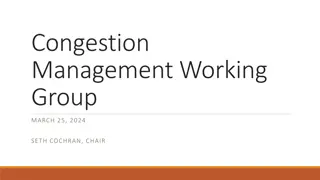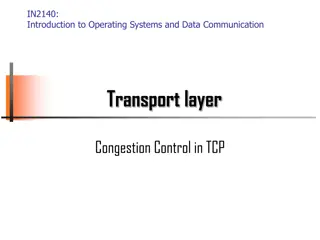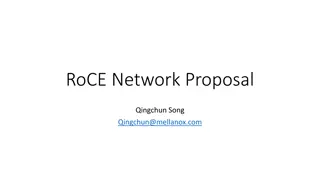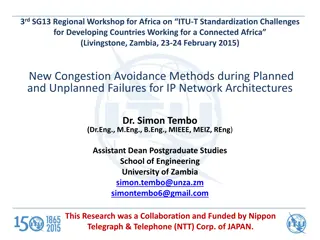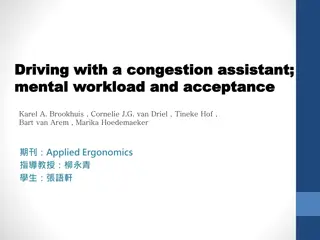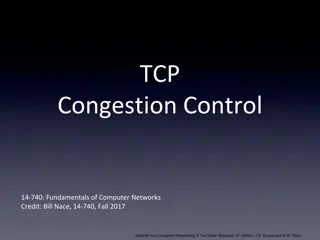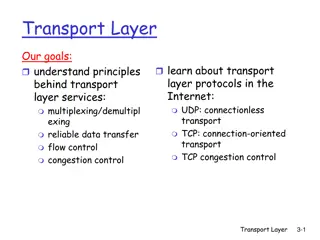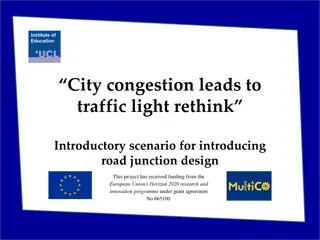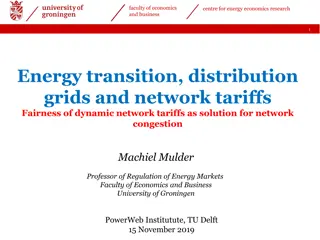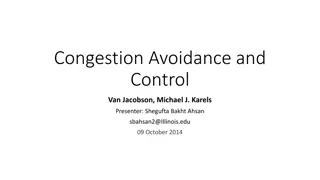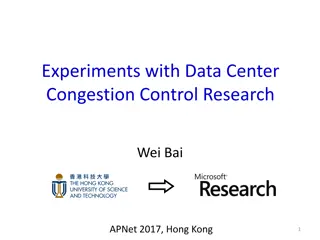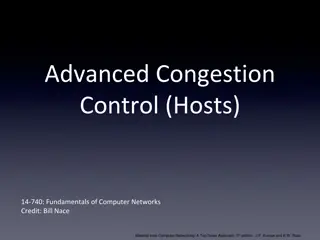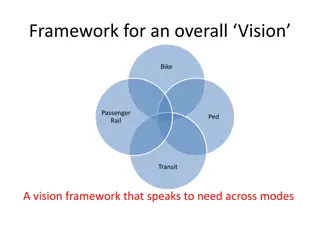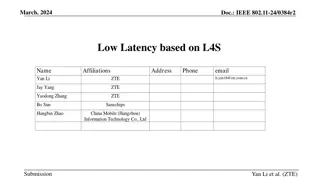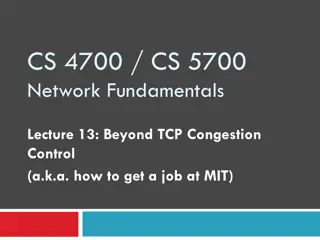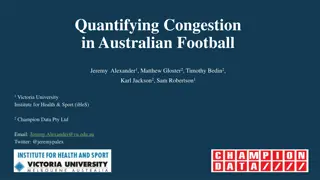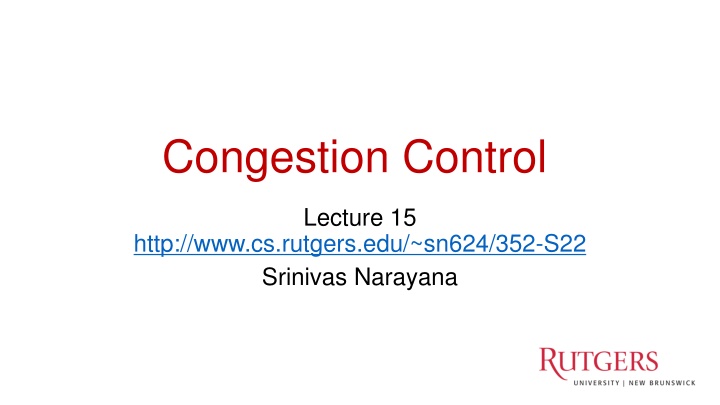
Understanding Congestion Control in Computer Networks
Explore the key concepts of congestion control in networking, including reordering impacts, TCP mechanisms, flow and congestion control, router buffering, sharing network resources among multiple endpoints, and the distributed algorithms used by the Internet for efficient outcomes.
Download Presentation

Please find below an Image/Link to download the presentation.
The content on the website is provided AS IS for your information and personal use only. It may not be sold, licensed, or shared on other websites without obtaining consent from the author. If you encounter any issues during the download, it is possible that the publisher has removed the file from their server.
You are allowed to download the files provided on this website for personal or commercial use, subject to the condition that they are used lawfully. All files are the property of their respective owners.
The content on the website is provided AS IS for your information and personal use only. It may not be sold, licensed, or shared on other websites without obtaining consent from the author.
E N D
Presentation Transcript
Congestion Control Lecture 15 http://www.cs.rutgers.edu/~sn624/352-S22 Srinivas Narayana 1
Quick recap of concepts Reordering degrades connection throughput. Apps can t recv(). Packets may even be dropped due to insufficient buffering. TCP: Reliability Ordering recv() Packet boundaries RTT Sequence numbers How much data to keep in flight? Stream-Oriented Transport
Multiple locations for bottlenecks application process sender recv() Flow Control TCP socket receiver buffers Congestion Control TCP code What s the bottleneck? How to adapt how much data to keep in flight? from sender Flow Control: Receiver informs sender free buffer over time receiver Last transmitted seq # Last cumulative ACK ed seq # Buffer >= desired W Sender s view: 0 3 1 0 4 1 2 5 7 6 Low socket buffering == Poor TCP throughput Window <= Advertised window
Routers have buffers which accommodate queued packets. Congestion Packets get dropped beyond max buffer Max amount of useful data that link can support, ~ link rate Too many retransmissions due to packet drops! Amount of useful (fresh) data plummets. Congestion collapse Amount of useful data that gets across to the receiver Queueing delay ~100% ~100% Link load Fraction of link used (link load) https://en.wikipedia.org/wiki/Network_congestion#Congestive_collapse
How should multiple endpoints share net? It is difficult to know where the bottleneck link is It is difficult to know how many other endpoints are using that link Endpoints may join and leave at any time Network paths may change over time, leading to different bottleneck links (with different link rates) over time
The approach that the Internet takes is to use a distributed algorithm to converge to an efficient and fair outcome.
The approach that the Internet takes is to use a distributed algorithm to converge to an efficient and fair outcome. No one can centrally view or control all the endpoints and bottlenecks in the Internet. Every endpoint must try to reach a globally good outcome by itself: i.e., in a distributed fashion. This also puts a lot of trust in endpoints.
The approach that the Internet takes is to use a distributed algorithm to converge to an efficient and fair outcome. If there is spare capacity in the bottleneck link, the endpoints should use it.
The approach that the Internet takes is to use a distributed algorithm to converge to an efficient and fair outcome. If there are N endpoints sharing a bottleneck link, they should be able to get equitable shares of the link s capacity. For example: 1/N th of the link capacity.
Flow Control vs. Congestion Control Avoid overwhelming the receiving application Avoid overwhelming the bottleneck network link Sender is managing the receiver s socket buffer Sender is managing the bottleneck link capacity and bottleneck router buffers
The approach that the Internet takes is to use a distributed algorithm to converge to an efficient and fair outcome. H C How to achieve this? Approach: sense and react Example: taking a shower Use a feedback loop with signals and knobs
Signals and Knobs in Congestion Control Signals Packets being ACK ed Packets being dropped (e.g. RTO fires) Packets being delayed (RTT) Rate of incoming ACKs Implicit feedback signals measured directly at sender. (There are also explicit signals that the network might provide.) Knobs What can you change to probe the available bottleneck capacity? Suppose receiver buffer is unbounded: Increase window/sending rate: e.g., add x or multiply by a factor of x Decrease window/sending rate: e.g., subtract x or reduce by a factor of x
Sense and react, surebut how? Where do you want to be? The steady state H C How do you get there? Congestion control algorithms Sense accurately React proportionately
The Steady State Efficiency of a single TCP conversation
What does efficiency look like? Suppose we want to achieve an efficient outcome for one TCP conversation by observing network signals from the endpoint Q: How should the endpoint behave at steady state? Challenge: bottleneck link is remotely located
Steady state: Ideal goal High sending rate: Use the full capacity of the bottleneck link Low delay: Minimize the overall delay of packets to get to the receiver Overall delay = propagation + queueing + transmission Assume propagation and transmission components fixed Low delay reduces to low queueing delay i.e., don t push so much data into the network that packets have to wait in queues Key question: When to send the next packet?
When to send the next packet? T Bottleneck link Fast link 1. Send packet burst (as allowed by window) Inter-packet delay T 2. Receive data packet 5. Send data packet on ACK Data T T Sender Receiver T 4. Receive ACK 3. Send ACK ACKs
Rationale When the sender receives an ACK, that s a signal that the previous packet has left the bottleneck link (and the rest of the network) Hence, it must be safe to send another packet without congesting the bottleneck link Such transmissions are said to follow packet conservation ACK clocking: Clock of ACKs governs packet transmissions
ACK clocking: analogy How to avoid crowding a grocery store? Strategy: Send the next waiting customer exactly when a customer exits the store However, this strategy alone can lead to inefficient use of resources
ACK clocking alone can be inefficient T Sender pushing data slowly Large delay T Send data packet on ACK Data T T Sender Receiver T ACKs
ACK clocking alone can be inefficient T Sender pushing data slowly Large delay T Send data packet on ACK Data Sender Receiver The sending rate should be high enough to keep the pipe full Analogy: a grocery store with only 1 customer in entire store If the store isn t full , you re using store space inefficiently
Steady State of Congestion Control Send at the highest rate possible (to keep the pipe full) while being ACK-clocked (to avoid congesting the pipe) So, how to get to steady state?
Getting to Steady State The Feedback Loop
An example of a feedback loop You H C Signals: Knobs: Turn temperature up/down Open the tap wider Water temperature Water pressure Your bathroom shower
The congestion control feedback loop TCP congestion control algorithm Signals: ACKs Knobs: Sending rate Congestion window Loss (RTOs), etc. Bottleneck link
Congestion window The sender maintains an estimate of the amount of in-flight data needed to keep the pipe full without congesting it. This estimate is called the congestion window (cwnd) Recall: There is a relationship between the sending rate (throughput) and the sender s window: sender transmits a window s worth of data over an RTT duration Rate = window / RTT
Interaction b/w flow & congestion control Use window = min(congestion window, receiver advertised window) Overwhelm neither the receiver nor network links & routers Window <= Congestion window (congestion control) Window <= Advertised window (flow control) Sender s view: 0 3 1 0 4 1 2 5 7 6 Last cumulative ACK ed seq # Last transmitted seq #


